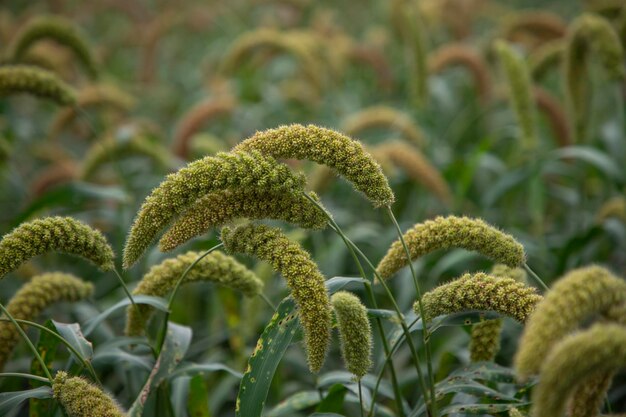Millet is a vital staple crop in many regions of South Africa, providing sustenance and income for countless farmers. However, one of the significant threats to millet production is the millet stem borer (Coniesta ignefusalis), a destructive pest that can cause significant yield losses if not identified and controlled early. Early detection is crucial for effective management. Here are 10 early signs that your millet may be infested with the millet stem borer:
1. Wilted Seedlings
One of the first signs of millet stem borer infestation is wilting in young seedlings. This occurs when the larvae feed on the base of the plant, cutting off the flow of water and nutrients. Wilting may start with just a few plants in a field but can spread rapidly.
2. Yellowing Leaves
Affected plants often show yellowing of leaves as the stem borers disrupt the plant’s ability to transport nutrients. This discoloration typically starts from the lower leaves and moves upwards. If left unchecked, this symptom can lead to the plant’s eventual death.
3. Holes in the Stem
One of the most distinct signs of stem borer infestation is the presence of small, circular holes in the stems of millet plants. These holes are entry points created by larvae as they burrow into the stems to feed. Inspect the base of the plant for these tiny openings, as they indicate active larvae within the stem.
4. Tunneling Inside the Stem
Upon closer inspection, you may notice tunneling or burrowing inside the stem. If you cut open an affected plant, you will often find the internal tissues eaten away. This tunneling weakens the plant structure, making it more susceptible to wind damage or lodging.
5. Sawdust-like Frass
Stem borer larvae produce frass (excrement) as they feed on the plant tissues. This frass resembles fine, sawdust-like particles and can often be seen around the stem base or near the holes where the larvae have entered. If you notice such material around your millet plants, it’s a clear sign of infestation.
6. Stunted Growth
Infected plants typically exhibit stunted growth compared to healthy millet plants. The larvae feed on the plant’s vascular tissues, restricting nutrient flow and severely limiting its ability to grow. A patchy field with shorter, unhealthy-looking plants may indicate a millet stem borer infestation.
7. Deadheart Formation
The term deadheart refers to the condition where the central whorl of the plant dries up and dies. This occurs because the larvae feed at the base of the plant’s growing point. Affected plants lose their vigor, and the dead central stem is a strong indicator that stem borers are present.
8. Broken or Lodged Stems
As the larvae weaken the internal structure of the stem through tunneling, plants become more prone to lodging (falling over) or breaking at the base. If you see sections of your millet field where plants have collapsed, inspect the stems closely for signs of infestation.
9. Delayed Ear Emergence
In more advanced infestations, millet plants may exhibit delayed or incomplete ear emergence. The damage caused by the stem borers interferes with the plant’s reproductive development, resulting in poor or no grain production. A delayed ear appearance can signal that stem borer damage has reached a critical stage.
10. Presence of Larvae in the Stems
Finally, the most definitive sign of millet stem borer infestation is the actual presence of larvae inside the stem. By splitting open the stem, you will often find the larvae feeding within. These larvae are typically white or pale yellow with a brown head, and their presence is the most conclusive evidence of infestation.
Control Measures
Once an infestation is confirmed, it’s important to take action to manage the millet stem borer population and prevent further crop damage. Here are a few control measures:
Cultural Practices:
- Crop rotation: Planting non-host crops such as legumes or root crops in the following season can disrupt the life cycle of the stem borer.
- Early planting: Millet stem borers are often less active early in the growing season. Planting early can help reduce exposure to high pest populations.
- Field sanitation: Remove and destroy crop residues after harvest, as the larvae can overwinter in stalks left in the field.
Biological Control:
- Encourage natural predators like parasitic wasps or release beneficial insects that prey on stem borers.
- Bacillus thuringiensis (Bt) is a biological pesticide that can be used to target stem borer larvae while being environmentally safe.
Chemical Control:
- Apply insecticides when necessary, but only after confirming that the pest population has reached an economic threshold. Common insecticides include pyrethroids or organophosphates like chlorpyrifos or lambda-cyhalothrin. Follow all local guidelines and instructions to avoid overuse or environmental harm.
- Granular insecticides applied to the base of plants can help control larvae in the early stages.
Monitoring and Scouting:
- Regularly scout your field for early signs of infestation, particularly during the early growing stages. Timely action can prevent severe losses.
- Use pheromone traps to monitor adult moth activity and time pesticide applications when the pest population is most vulnerable.
Early detection of millet stem borer infestation is critical for minimizing crop losses and maintaining healthy millet fields. By regularly inspecting your crops for these early signs—wilted seedlings, yellowing leaves, stem holes, and frass—you can take action before the infestation spreads. Combining cultural practices, biological controls, and selective use of pesticides can help South African farmers effectively manage millet stem borer populations and protect their crops.
Join 'Farmers Mag' WhatsApp Channel
Get the latest Farming news and tips delivered straight to your WhatsApp
CLICK HERE TO JOIN






